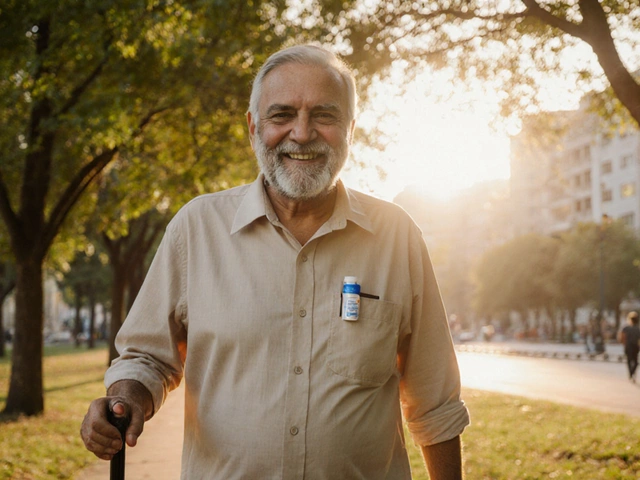Knee replacement surgery is a big deal, and getting back on your feet quickly is often the top priority. So, what's the fastest way to recover? It starts with understanding the process. Knowing what your body is going through can give you a leg up—no pun intended—in healing.
Rehabilitation isn't just important; it's crucial. The exercises might seem tedious, but trust me, they'll make a huge difference. Your physiotherapist is your new best friend. A good rehab plan is like having a roadmap for recovery.
Don't underestimate the power of nutrition. Eating the right foods can speed up healing and boost your energy. Think of your body as a car. The better fuel you provide, the better it runs. Lean proteins, whole grains, and fresh veggies should be your go-to.
- Understanding Knee Replacement Recovery
- Importance of Rehabilitation
- Nutrition and Healing
- Managing Pain Effectively
- Staying Active Safely
- Common Mistakes to Avoid
Understanding Knee Replacement Recovery
So, you've had a knee replacement surgery. What now? This part of the journey is all about figuring out what your body is going through and what it needs to bounce back.
First off, let’s get into the nitty-gritty of what happens after the surgery. The actual implants used in knee replacement are designed to mimic the natural motion of a knee joint. But adaptation takes time and patience. The recovery isn't just physical; it's mental too. Trust me, the right mindset makes all the difference.
The Initial Days
Right after surgery, you might feel a bit tangled up with tubes and gadgets in the hospital. This is standard procedure to keep track of vitals and manage pain. Walking a few steps with a walker might even be encouraged as early as day one. It's all about blood circulation and preventing complications.
"Early mobilization after knee replacement is key to a successful recovery, reducing the risk of clots and improving overall outcomes," says Dr. Elena Garcia, an orthopedic surgeon with 20 years of experience.
The Role of Swelling and Healing
Remember, swelling is your body's natural response to surgery. It can stick around for weeks but will gradually ease off. Ice packs are your friends here.
Setting Realistic Expectations
Everyone’s recovery timeline is different. Some folks are back to their favorite activities sooner than others. A lot depends on personal health, age, and how religiously you follow through with rehab.
Statistics That Matter
| Recovery Milestones | Expected Time Frame |
|---|---|
| Walking Independently | 2-4 weeks |
| Returning to Work | 4-6 weeks |
| Resuming Physical Activities | 10-12 weeks |
In short, understanding knee replacement recovery involves knowing the process, setting smart goals, and being patient with yourself. It might feel like a marathon, but with the right steps, you’ll cross that finish line stronger than ever.
Importance of Rehabilitation
When it comes to knee replacement recovery, rehabilitation is a game-changer. Seriously, it’s the backbone of bouncing back quickly. Many people might not realize how much rehab can affect the speed and quality of their recovery. Skipping it is not an option if you want to get the most out of your new knee.
Why Rehab Matters
Rehabilitation doesn't just mean a few stretches when you remember; it’s a structured program designed for optimal results. Post-surgery, your knee can be stiff, and the surrounding muscles might be weak. Following a personalized rehab plan helps restore strength, flexibility, and movement.
More importantly, starting rehab soon after surgery can prevent complications like blood clots and improve overall mobility. Studies show that engaging in physiotherapy within 24 hours can speed up the recovery process significantly.
What to Expect
Your physiotherapist will guide you with exercises that focus on rebuilding muscle strength and improving your range of motion. Here’s a snapshot of what a typical rehab journey might involve:
- Day 1-7: Gentle movements focusing on regaining range of motion.
- Week 2-4: More demanding exercises to strengthen the leg muscles.
- Week 4-6: Incorporating more weight-bearing activities and balance exercises.
Benefits You Should Know
Getting stuck into your rehab plan can also improve mental well-being. Setting small goals and achieving them can boost your mood and motivation.
Here are the benefits of sticking to rehabilitation:
- Quicker return to daily activities
- Reduced pain and swelling
- Lower risk of post-surgery complications
And here’s an interesting stat for you. A 2023 survey found that 85% of patients who followed their physio program reported regaining full function within six months. Clearly, rehab is your ticket to regaining a normal life faster.
So, if you’re serious about recovering quickly after a knee replacement, invest your energy into rehab. It might not be a joyride, but the benefits are absolutely worth the effort.
Nutrition and Healing
Ever heard the saying, "You are what you eat"? That's especially true when it comes to recovering from a knee replacement. Your body needs the right nutrients to bounce back quickly. So, loading up on certain foods can make a world of difference.
Power Foods for Recovery
First off, think protein, and lots of it. Your body needs protein to repair tissues, so this is the time to embrace lean meats, fish, beans, and nuts. Eggs are a great option too. They’re not just versatile; they’re packed with quality protein.
Don't forget about antioxidants. These bad boys fight off inflammation, which is key after surgery. Fill your plate with colorful fruits and veggies—think berries, spinach, and sweet potatoes. They’re not only good for healing; they also taste pretty great.
Calcium and Vitamin D
Your bones need some love too. Calcium and Vitamin D are essential for keeping them strong. Dairy products, fortified cereals, and leafy greens are excellent choices. And if you can catch some sunshine, it helps your body make Vitamin D. Just don’t overdo it!
Hydration Is Key
Water, water, and more water. Staying hydrated is often overlooked, but it’s vital for recovery. Water helps nutrients get where they need to go. Aim for at least 8 glasses a day. Your joints will thank you.
Fast Recovery Tips
- Avoid processed foods that can slow down healing.
- Cut back on salt to help minimize swelling.
- Consider consulting a nutritionist for a balanced diet plan.
Here's a quick look at some top foods to include in your post-surgery diet:
| Food | Benefits |
|---|---|
| Salmon | Rich in Omega-3 for reducing inflammation |
| Broccoli | High in Vitamin C, aids tissue repair |
| Greek Yogurt | Loaded with protein and probiotics |
Getting the right nutrition post-surgery isn't just about the foods you eat. It's about fueling your body for a more efficient and fast recovery.

Managing Pain Effectively
Pain is part and parcel of knee replacement recovery, but it doesn't have to dominate your life. Let's talk about some solid ways to handle it, so you're not sidelined by discomfort.
Medication Matters
First off, talk with your doctor about a pain management plan that suits you. They might prescribe medications or suggest over-the-counter options. That's why good communication is key—keep them in the loop if your pain is overpowering those meds.
Cold Therapy
Remember those bags of frozen peas? They're not just for dinner. Using cold packs on your knee can help reduce swelling and numb the area. Aim to ice for about 15-20 minutes every couple of hours, especially after exercises.
Staying Active
Yes, it might feel counterintuitive, but staying active can lessen pain. Gentle movements boost circulation and help prevent stiffness. Keep up with those prescribed exercises. They're your best friend in the fight against pain.
Complementary Techniques
Consider adding techniques like deep breathing, meditation, or even acupuncture. These can sometimes lower stress levels, which indirectly eases pain.
| Technique | Benefits |
|---|---|
| Ice Packs | Reduces swelling and numbs pain |
| Medication | Direct pain relief |
| Physical Therapy | Improves mobility and reduces stiffness |
| Meditation | Lowers stress, helping with pain perception |
The goal is to find a mix of strategies that suit you personally. Everyone’s pain is different, so it’s all about getting that custom fit for your needs.
Staying Active Safely
After a knee replacement surgery, the idea of staying active might seem like a pipe dream, but it’s not only possible—it’s necessary. Movement is key to maintaining muscle strength and joint flexibility. The trick is to do it without overdoing it.
Start Slowly and Build Up
Jumping back into old routines too quickly can be risky. Begin with simple exercises, like walking or light stretching. These activities keep your joints lubricated and muscles engaged without putting too much stress on your new knee.
Follow a Guided Exercise Plan
Your physiotherapist will likely give you a set of exercises tailored just for your needs. These plans are essential because they ensure that you're working all the right muscle groups without risking injury. Stick to the plan religiously, and remember to ask your therapist if you're unsure about a particular exercise.
The Power of Low-Impact Exercises
Engage in low-impact activities like swimming or cycling. These are excellent for maintaining cardiovascular health and strengthening muscles, especially for those recovering from a knee replacement. Water aerobics can be particularly effective because water supports your weight, reducing stress on your knee.
- Swimming
- Cycling
- Yoga (gentle poses)
Listen to Your Body
Pain is your body talking, so pay attention. A little soreness is normal, but sharp or intense pain is a red flag. Stop the activity immediately if you feel anything more than mild discomfort. Rest and ice are your friends in these moments.
Balance Activity With Rest
Rest is as important as exercise. Make sure you’re not just training your knee but also giving it time to recover. Overexertion can lead to setbacks, so scheduling downtime is key to a balanced recovery plan.
| Activity | Recommended Duration (Per Day) |
|---|---|
| Walking | 10-30 minutes |
| Cycling | 15-20 minutes |
| Yoga | 20-30 minutes |
Common Mistakes to Avoid
Recovering from a knee replacement surgery might seem straightforward, but there are plenty of pitfalls that can slow you down. Let's talk about what not to do when you're on the road to recovery.
Skipping Rehab Sessions
You might feel like you've got this, but missing rehab appointments is a major no-no. Each session is designed to help you regain strength and mobility. Think of it like missing a class—it's going to catch up with you sooner or later.
Overexertion
It's easy to think that pushing yourself will speed things up. Reality check: overdoing it can lead to setbacks. Listen to your body. You'll feel better sooner by following a consistent but manageable exercise plan.
Ignoring Pain Management
Let's be real, ignoring pain isn't a badge of honor. Controlling pain helps you move better and do your exercises with ease. Talk with your doctor about finding the right balance of medication and other pain relief methods.
Poor Nutrition Choices
Eating junk isn't just bad for your waistline; it slows down healing. Your body needs good fuel to mend tissues and build strength. Skipping out on nutritious meals is like trying to run a marathon with no training.
Neglecting Rest
In the hustle to recover quickly, don't underestimate the power of sleep. Rest helps repair tissue and reduces inflammation. It's not just about bed rest; it's quality sleep that does the magic.
| Common Mistake | Consequence |
|---|---|
| Skipping rehab | Delayed recovery, possible re-injury |
| Overexertion | Increased pain, risk of setbacks |
| Ignoring pain management | Reduced mobility |
| Poor nutrition | Slower healing, less energy |
| Lack of rest | Slower tissue repair |






